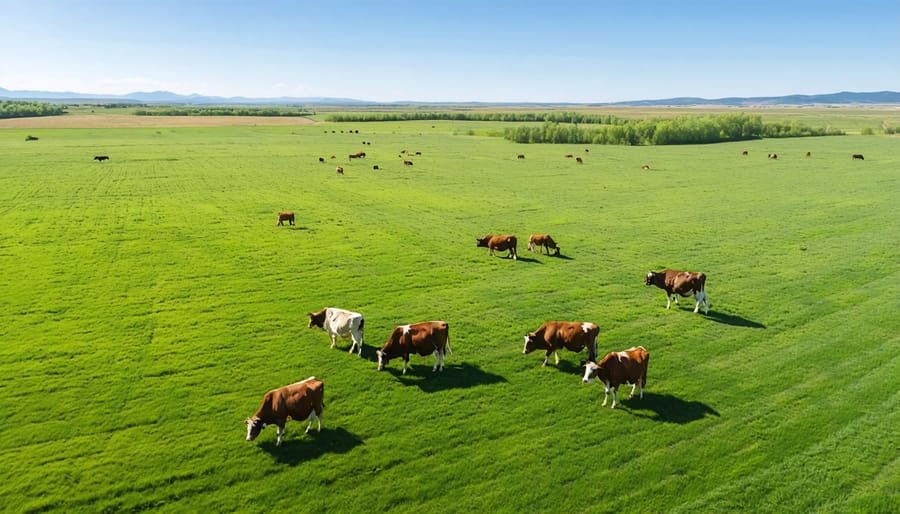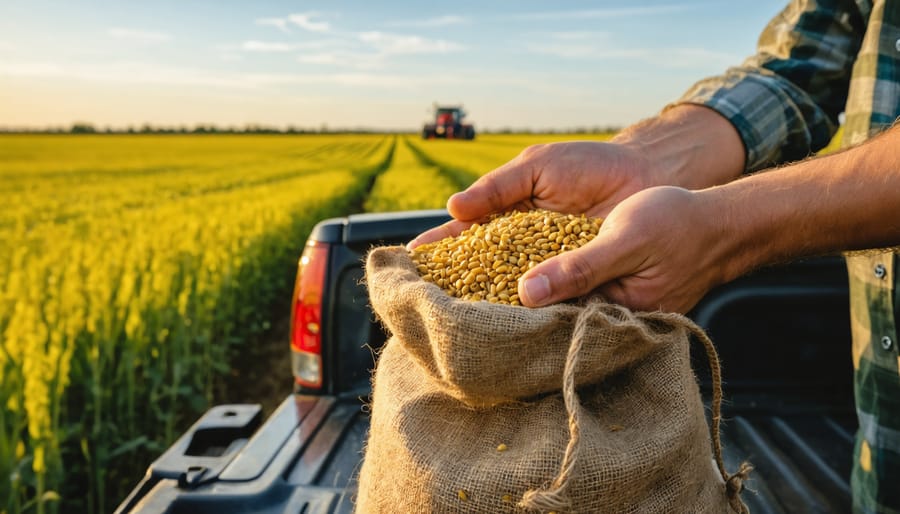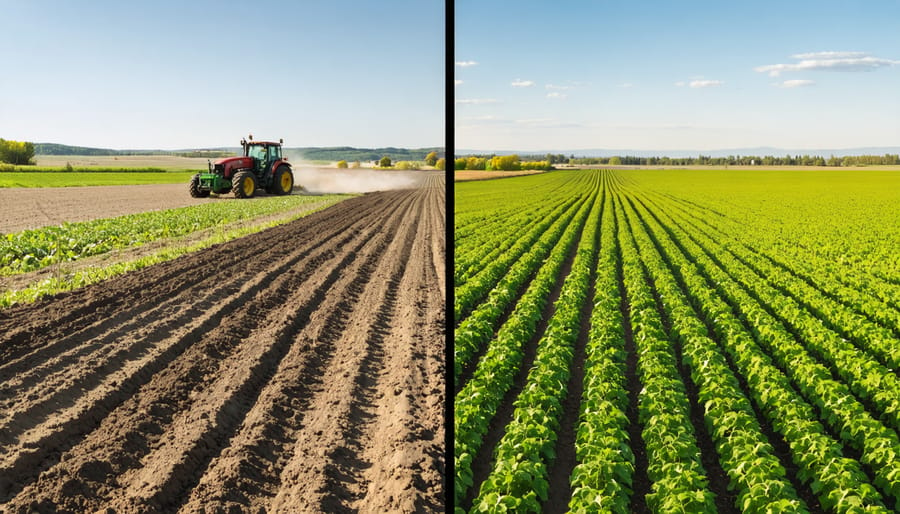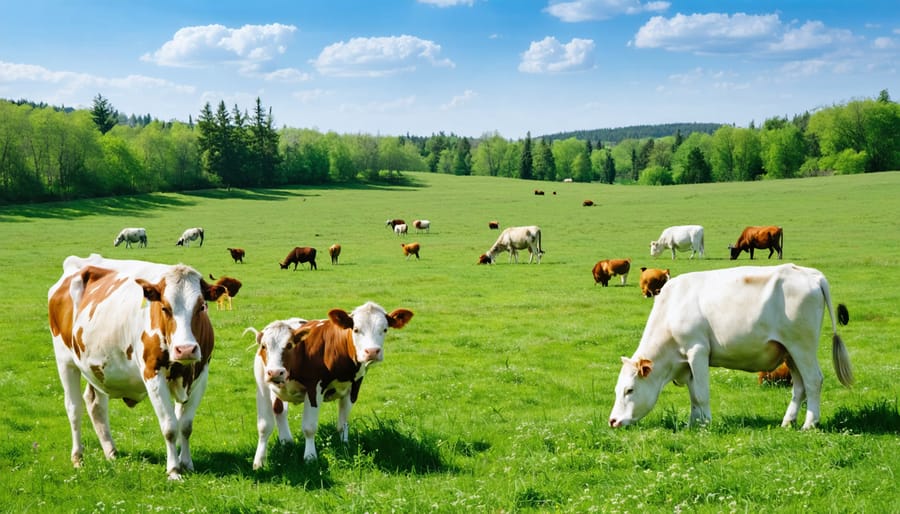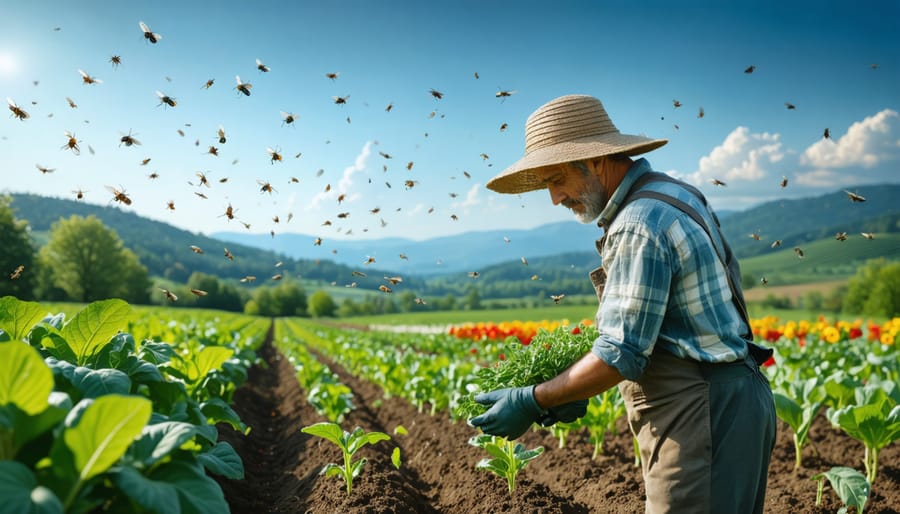Organic farming revolutionizes Canadian agriculture by working in harmony with natural ecosystems while meeting our growing food demands. From the rolling prairies of Alberta to the fertile valleys of British Columbia, farmers are discovering that organic methods not only protect our soil and water resources but also often match or exceed conventional yields. Recent studies from the University of Alberta demonstrate that organic farms support 30% more biodiversity and sequester up to 25% more carbon than their conventional counterparts. Yet, the environmental impact of organic farming extends beyond these immediate benefits. As we face increasing climate challenges and mounting pressure on our agricultural systems, understanding the true ecological footprint of organic practices becomes crucial for Canadian farmers and consumers alike. This comprehensive analysis explores how organic farming methods influence soil health, water quality, biodiversity, and greenhouse gas emissions, with particular attention to the unique challenges and opportunities within Alberta’s diverse agricultural landscape. Through evidence-based research and real-world examples from local farmers, we’ll examine both the benefits and limitations of organic farming in creating a more sustainable agricultural future for Canada.
The Core Standards: How Organic Certification Shapes Animal Care
Key Animal Welfare Requirements in Canadian Organic Standards
Canadian organic animal welfare standards prioritize natural behaviors and comfort while supporting environmental sustainability. Livestock must have regular access to outdoor areas, pasture, and fresh air, with adequate space for movement and socialization. For cattle, this means a minimum of 6 square metres per animal in indoor spaces and access to grazing during the growing season.
Housing facilities must maintain proper ventilation and natural lighting, with clean, dry bedding made from organic materials. The standards prohibit continuous confinement and require that animals can express natural behaviors such as dust bathing for poultry and rooting for pigs.
Feed must be 100% organic, including pasture, and adapted to the animal’s nutritional requirements. Preventive health care focuses on natural methods, stress reduction, and appropriate breeding selections. The use of synthetic medications is strictly limited, with emphasis on prevention through good management practices.
These requirements create a balanced approach that benefits both animal welfare and environmental stewardship, particularly relevant for Alberta’s diverse farming operations.
Alberta’s Unique Implementation Challenges
Alberta’s organic farmers face unique challenges due to the province’s distinct climate and agricultural landscape. The short growing season, typically ranging from 90 to 120 days, requires careful crop selection and timing. Our harsh winters and unpredictable spring conditions often necessitate innovative soil management strategies to maintain organic certification while protecting against erosion.
Water management presents another significant hurdle, particularly in southern Alberta’s semi-arid regions. Organic farmers must develop efficient irrigation systems while adhering to natural resource conservation principles. The challenge of weed control becomes especially pronounced in our wide-open prairies, where wind can spread seeds across vast distances.
Local organic producers have developed region-specific solutions, such as implementing strategic crop rotations that account for Alberta’s specific pest cycles and utilizing cold-hardy cover crops. Many successful operations have found that integrating livestock into their farming systems helps maintain soil fertility naturally while providing additional income streams.
Collaboration through local farming networks has proven essential, with experienced organic farmers mentoring newcomers on Alberta-specific challenges and solutions. This community-based approach has helped strengthen the province’s organic farming sector despite these regional hurdles.
Environmental Benefits That Enhance Animal Well-being
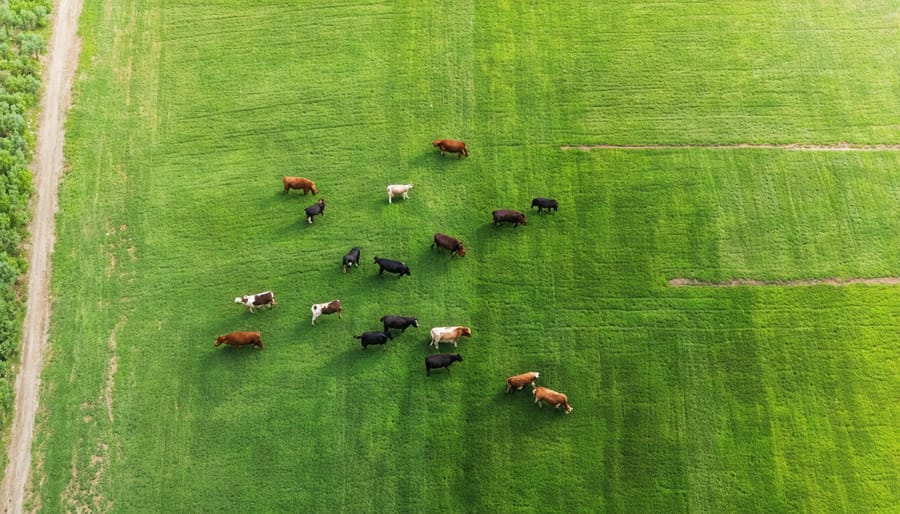
Pasture Management and Soil Health
The integration of livestock with organic farming creates a powerful synergy for environmental sustainability. Soil health practices in Alberta have shown that rotational grazing and proper pasture management significantly improve soil structure and fertility while supporting animal nutrition.
When cattle graze on diverse pastures, they naturally fertilize the soil through manure deposits, which increases organic matter content and enhances microbial activity. This creates a beneficial cycle where healthier soil produces more nutritious forage, leading to better-nourished livestock. Many Alberta farmers have observed that implementing planned grazing patterns allows pastures to recover fully between grazing periods, resulting in deeper root systems and improved drought resistance.
The key to successful pasture management lies in maintaining an optimal balance of grass height and recovery time. Experienced ranchers recommend keeping grass heights between 10-15 cm during grazing and allowing 30-45 days of rest between rotations, depending on seasonal conditions. This approach not only prevents overgrazing but also promotes carbon sequestration in the soil.
Local success stories, like the Morrison Family Farm near Red Deer, demonstrate how implementing these practices has increased their soil organic matter by 2% over five years while reducing feed costs by 30%. Their carefully managed pastures now support more animals per hectare while maintaining excellent soil health indicators.
Regular soil testing and monitoring of plant diversity help farmers adjust their grazing plans to optimize both animal nutrition and soil improvement. This integrated approach ensures long-term sustainability while maintaining profitable farming operations.
Natural Pest Control Methods
In Alberta’s organic farming landscape, organic pest control methods have shown remarkable success in protecting crops while maintaining ecological balance. These approaches focus on working with nature rather than against it, creating resilient agricultural systems that benefit both farmers and the environment.
Beneficial insects play a crucial role in natural pest management. Local farmers have reported significant success with introducing ladybugs, praying mantises, and parasitic wasps to control harmful pests. These beneficial insects help maintain pest populations at manageable levels without the need for synthetic pesticides, protecting soil and water quality in the process.
Crop rotation and companion planting have emerged as particularly effective strategies in the Prairie provinces. For instance, planting aromatic herbs like dill and cilantro alongside vegetables naturally deters many common pests while attracting beneficial insects. Many Alberta farmers integrate trap crops – plants that attract pests away from the main crop – creating a natural barrier that protects their primary produce.
Physical barriers and cultural controls have also proven effective. Row covers, sticky traps, and proper timing of planting and harvesting help minimize pest damage without chemical intervention. These methods have shown particular success in market gardens across central Alberta, where farmers report reduced crop losses while maintaining soil health.
Recent studies from the University of Alberta demonstrate that farms using these natural pest management strategies typically show higher biodiversity levels, with increased populations of native birds and beneficial insects. This enhanced biodiversity creates a self-regulating ecosystem that naturally keeps pest populations in check while supporting pollinator health.

Real Results: Alberta Success Stories
Prairie Beef Producer Perspective
Tom Anderson, a third-generation cattle farmer from Red Deer County, made the switch to organic farming fifteen years ago. “Initially, I was skeptical about organic practices affecting our productivity,” he shares, “but the results have been remarkable, both for our land and our bottom line.”
Anderson’s 800-hectare operation now supports 200 head of cattle using rotational grazing methods that have significantly improved soil health. “We’ve noticed a dramatic increase in native grass species and soil organic matter since switching to organic,” he explains. “Our cattle are healthier, and we’re using about 40% less water than we did under conventional management.”
The transition wasn’t without challenges. Anderson spent three years adapting his land management practices to meet organic certification requirements. “The key was focusing on soil biology and natural pest management,” he notes. “We’ve eliminated synthetic fertilizers and instead rely on carefully managed grazing patterns and composted manure.”
The farm now serves as a model for sustainable beef production in Alberta. Anderson regularly hosts field days for other producers interested in organic methods. “The environmental benefits are clear,” he states. “We’re seeing more wildlife, better water retention, and our soil tests show increasing carbon sequestration year over year. Plus, there’s growing market demand for organic beef, which has helped offset the initial conversion costs.”
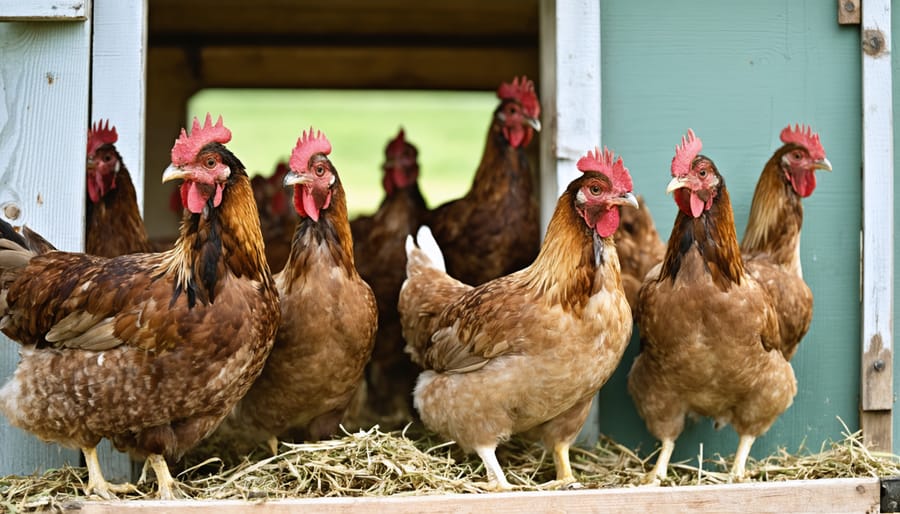
Small-Scale Poultry Operation Insights
The Green Meadows Farm in Lacombe County demonstrates how small-scale organic poultry operations can successfully balance environmental stewardship with profitable farming. Operating since 2015, this 10-hectare family farm manages 500 laying hens and 1,000 meat birds annually while maintaining organic certification under Canadian standards.
Owner Sarah Thompson implemented several innovative practices that have reduced the farm’s environmental footprint. By rotating portable chicken coops across pastures every three days, the farm naturally fertilizes soil while preventing overgrazing and soil compaction. This method has improved soil organic matter by 2.5% over five years, as measured through regular soil testing.
The farm uses solar-powered mobile watering systems and wind barriers made from native shrubs, reducing energy consumption while protecting birds from harsh Alberta winters. Food waste is minimized through precise feed management, with approximately 95% of feed sourced from local organic grain producers within a 100-kilometre radius.
Water quality testing shows a 40% reduction in nitrogen runoff compared to conventional operations of similar size, achieved through careful manure management and strategic paddock rotation. The farm also maintains biodiversity through integrated pest management, using heritage chicken breeds that naturally control insects while preserving genetic diversity.
These practices have resulted in a 30% lower carbon footprint compared to conventional poultry operations, while maintaining production levels that support the farm’s economic viability.
Practical Implementation Steps
Assessment and Planning Tools
Several practical tools are available to help Alberta farmers assess and plan their environmental impact while meeting organic certification requirements. The Environmental Farm Plan (EFP) program, offered through the Agricultural Research and Extension Council of Alberta, provides a comprehensive self-assessment workbook that helps farmers evaluate their current practices and identify areas for improvement.
Digital mapping tools like the Canadian Agricultural Partnership’s Field to Market Calculator allow farmers to track their carbon footprint, water usage, and soil health metrics. These resources provide valuable data visualization and help measure progress toward sustainability goals.
The Organic Agriculture Centre of Canada offers specialized assessment checklists designed specifically for organic operations, helping farmers track biodiversity, soil organic matter, and ecosystem services on their land. These tools are particularly useful during the transition period to organic farming.
Local agricultural extension offices provide soil testing kits and interpretation services, which are essential for maintaining optimal soil health without synthetic inputs. Additionally, the Prairie Organic Grain Initiative’s online calculator helps farmers estimate the economic impacts of transitioning to organic practices while considering environmental benefits.
For water management assessment, the Alberta Irrigation Management Model is an invaluable tool that helps farmers optimize irrigation scheduling while minimizing environmental impact and conserving water resources.
Cost-Effective Transition Strategies
Making the switch to organic farming doesn’t have to break the bank. Many Alberta farmers have successfully transitioned using a phased approach that spreads costs over 3-5 years. Starting with a portion of your land – typically 10-20% – allows you to test organic methods while maintaining steady income from conventional operations.
Local agricultural extension services offer free transition planning support, and several government programs can help offset initial certification costs. The Canadian Agricultural Partnership provides grants covering up to 75% of organic certification expenses for first-time applicants.
Consider starting with lower-input crops like legumes or hay, which require fewer amendments during transition. These crops can improve soil health while generating revenue. Many Alberta farmers have found success by partnering with experienced organic producers through mentorship programs, sharing equipment and knowledge to reduce startup costs.
Local organic farming cooperatives often provide members with bulk purchasing power for approved inputs and shared marketing opportunities. Some processors and retailers offer transition contracts with premium prices, helping to offset reduced yields during the conversion period.
Remember that improved soil health from organic practices often leads to reduced input costs over time. According to Alberta Agriculture data, established organic farms typically spend 25-40% less on inputs compared to conventional operations, though labor costs may be higher initially.
As we’ve explored throughout this article, organic farming offers significant potential for environmental stewardship while maintaining productive agricultural operations here in Alberta. The evidence clearly shows that organic practices contribute to improved soil health, enhanced biodiversity, and reduced chemical inputs – all crucial factors for our province’s agricultural future.
For Alberta farmers considering the transition to organic methods, remember that every step toward sustainable practices counts. Whether you’re starting with a small portion of your land or planning a complete conversion, your efforts contribute to our collective environmental responsibility. The success stories we’ve shared from local farmers demonstrate that organic farming can be both environmentally and economically viable in our unique climate conditions.
Looking ahead, the growing demand for organic products and increasing support from agricultural organizations provide excellent opportunities for Alberta farmers to lead in sustainable agriculture. By implementing organic practices like crop rotation, natural pest management, and soil conservation techniques, we’re not just protecting our environment – we’re investing in the long-term viability of our farms.
Let’s continue working together as a farming community to share knowledge, support one another, and build a more sustainable agricultural future for Alberta. Remember, the journey to organic farming is a gradual process, and every sustainable choice makes a difference in preserving our precious natural resources for future generations.

